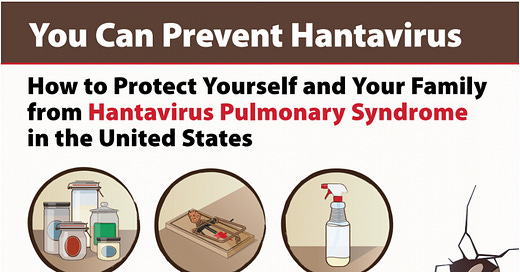3rd hantavirus death of the year in the town of Mammoth Lakes, Mono County, California
In a follow-up from the town of Mammoth Lakes, in Mono County, California (HERE and HERE), county health officials report the confirmation of a third hantavirus death.
“A third case of hantavirus pulmonary syndrome (HPS), each of which has been fatal, is tragic and alarming,” said Dr. Tom Boo, Mono County's public health officer. “We don’t have a clear sense of where this young adult may have contracted the virus."
Investigators found no evidence of mouse activity in the patient's home, Boo said in a press release announcing the death. While some mice were detected in the patient's workplace, their numbers were not unusual for this time of year in Mammoth Lakes, he added.
"We haven't identified any other activities in the weeks before illness that would have increased this person's exposure to mice or their droppings," Boo said.
"The occurrence of three cases in a short period has me worried, especially this early in the year," Boo said. "Historically, we tend to see hantavirus cases later in the spring and in the summer."
Mammoth Lakes is located on the eastern side of California's Sierra Nevada mountains. With a population of more than 7,000, the area is known for its skiing and trails.
While Boo said deer mice are widespread in the eastern Sierra, they believe numbers are high this year — including in Mammoth Lakes — increasing the risk of exposure.
Mono County has recorded 27 cases of hantavirus since the first county case was detected in 1993; 21 cases were county residents, and six were visitors.
Since 1980, California's Department of Public Health has reported fewer than 100 cases.
Hantavirus spreads through urine, droppings (poop), or saliva of mice. In California, Hantavirus is carried by deer mice specifically, which are common in Mono County. You are most likely to catch hantavirus indoors, especially in rooms or buildings that have been closed for a long time and don't have air circulation.
Hantavirus exposure can lead to Hantavirus Pulmonary Syndrome (HPS) which includes:
Early symptoms (1-8 weeks after exposure):
fatigue
fever
muscle aches, especially in the large muscle groups like the thighs, hips, back, and sometimes shoulders
headaches
dizziness
chills
Later symptoms (4-10 days after initial phase of illness):
coughing
shortness of breath
tightness in chest as lungs fill with fluid
HPS can be deadly. 38% of people who develop respiratory symptoms may die from the disease.
Eliminating hantavirus exposure requires a multi-step process. Because it originates from exposure to rodent droppings (poop), saliva, and urine, removing these from your home and surrounding area is crucial.
You can take the following steps to minimize your risk:
Ventilate the affected space by opening windows, using an air filter, and creating a cross-breeze for at least 30 minutes
Wet down contaminated area with disinfectants like bleach or lysol and let sit for 5 minutes
Do NOT vacuum or sweep, as this can stir up particles into air
Bleach must be mixed up fresh, with at least one-part bleach to 10 parts water
Allow disinfectant to stand for at least 5 minutes
Wear disposable rubber or latex gloves and a mask (if possible) -For highly infested areas, use a well-fitting N-95 mask or respirator
Mop or clean area with paper towels and promptly dispose of cleaning materials. Be sure to wash hands and clothes after.
Set mouse traps and seal any holes and gaps around doors and windows to prevent future rodent entry.






